英语论文 归化与异化翻译
- 格式:doc
- 大小:159.00 KB
- 文档页数:36
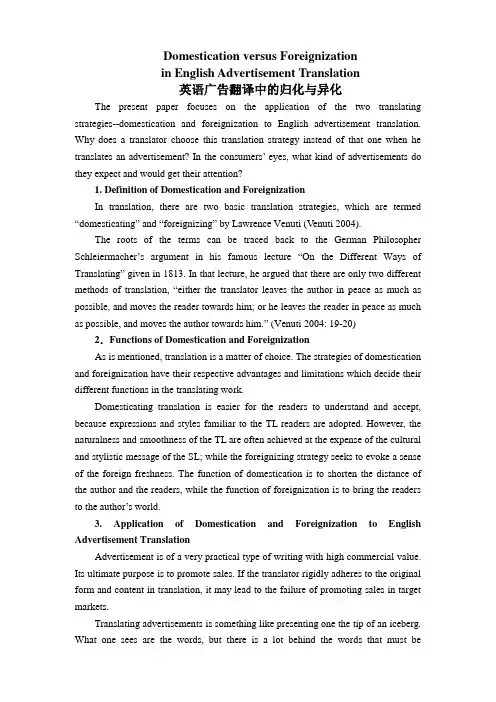
Domestication versus Foreignizationin English Advertisement Translation英语广告翻译中的归化与异化The present paper focuses on the application of the two translating strategies--domestication and foreignization to English advertisement translation. Why does a translator choose this translation strategy instead of that one when he translates an advertisement? In the consumers’ eyes, what kind of advertisements do they expect and would get their attention?1. Definition of Domestication and ForeignizationIn translation, there are two basic translation strategies, which are termed “domesticating” and “foreignizing” by Lawrence Venuti (Venuti 2004).The roots of the terms can be traced back to the German Philosopher Schleiermacher’s argument in his famous lecture “On the Different Ways of Translating” given in 1813. In that lecture, he argued that there are only two different methods of translation, “either the translator leaves the author in peace as much as possible, and moves the reader towards him; or he leaves the reader in peace as much as possible, and moves the author towards him.” (Venuti 2004: 19-20) 2.Functions of Domestication and ForeignizationAs is mentioned, translation is a matter of choice. The strategies of domestication and foreignization have their respective advantages and limitations which decide their different functions in the translating work.Domesticating translation is easier for the readers to understand and accept, because expressions and styles familiar to the TL readers are adopted. However, the naturalness and smoothness of the TL are often achieved at the expense of the cultural and stylistic message of the SL; while the foreignizing strategy seeks to evoke a sense of the foreign freshness. The function of domestication is to shorten the distance of the author and the readers, while the function of foreignization is to bring the readers to the author’s world.3. Application of Domestication and Foreignization to English Advertisement TranslationAdvertisement is of a very practical type of writing with high commercial value. Its ultimate purpose is to promote sales. If the translator rigidly adheres to the original form and content in translation, it may lead to the failure of promoting sales in target markets.Translating advertisements is something like presenting one the tip of an iceberg. What one sees are the words, but there is a lot behind the words that must beunderstood to transfer advertising from one culture to another.The production of an advertising text involves considerable market research, so that the intended audience can be very carefully targeted, the right buttons pressed and the desired responses elicited.On the other hand, with the development of cultural communication in different countries, the situation has gradually changed in a subtle way. Nowadays, more and more people tend to accept the foreign culture and even eager to learn some necessary information globally through different ways. The discrepancy between SL and TL in the aspects of language and culture would attract them and arouse their interests.4. ConclusionIn the business flow between countries, the advertisement, as one of the important ways to spread information, carries messages from one country to another. The advertising messages may contain different cultural factors such as language, values, history, customs and the like which need to be dealt with in advertising translation. So the advertisement translation is a complex job, which not only requires transiting and passing on the foreign cultural elements, but also calls for considering whether the consumers would accept this kind of transition.References[1]Adab, Beverly, ed. 2004. The Translator—Key Debates in the Translation of Advertising Material[M]. Manchester, UK: St. Jerome Publishing.[2]Baker, Mona. 2000.In Other Words: A Coursebook on Translation[M].Beijing: Foreign Language Teaching and Research Press.[3]Bassnett, Susan. 2004. Translation Studies[M]. Shanghai: Shanghai Foreign Language Education Press.[4]Belch, George E. & Belch Michael A. 2001. Advertising and Promotion: An Integrated Marketing Communication Perspective[M]. New York: Irwin/ McGraw-Hill.[5]Lefevere, Andre, ed. 2004. Translation, History & Culture: A Sourcebook[M].Shanghai: Shanghai Foreign Language Education Press.[6]Venuti, Lawerence. 2004. The Translator’s Invisibility—A History of Translation[M]. Shanghai: Shanghai Foreign Language Education Press.[7]Jin Hanshen靳涵身. 《诗型广告翻译研究》[M]. 成都:四川大学出版社. 2004.[8]Sun Huijun 孙会军.《普遍与差异—后殖民批评视阈下的翻译研究》[M]. 上海:上海译文出版社. 2005.[9]Xie Tianzheng 谢天振. 《翻译研究新视野》[M]. 青岛:青岛出版社. 2003.[10]Zhou Xiao Zhou Yi 周晓,周怡. 《现代英语广告》[M]. 上海:上海外语教育出版社. 1998.。
![功能翻译目论下归化和异化[论文]](https://uimg.taocdn.com/13e859f3941ea76e58fa0418.webp)
功能翻译目的论下的归化和异化摘要:归化与异化是翻译实践中,译者需要选择并采用的两种翻译策略,是因其在翻译中的文化取向来定义的。
归化通常是以源语文化为归宿,而异化则是以目的语文化为归宿。
本文尝试采用德国学者hans vermeer的“目的论”原则,通过翻译实例说明在翻译具体操作环节,译者可以依据源语文本传播目的来决定重归化或异化,从而达到“目的论”中所倡导的:翻译必须要确定原文目的,实现目的在文化间整体平移。
关键词:归化异化目的论一、前言在1978年,德国学者hans vermeer提出了他著名的”目的论”,被认为是功能翻译理论的里程碑式的突破。
他认为,翻译时,译者应根据客户或委托人的要求,结合翻译的目的和译文读者的特殊情况,从原作所提供的多源信息中进行选择性的翻。
hans vermeer还特别强调因为行为发生的环境处于文化背景之中,不同文化又具有不同的风俗习惯和价值观,因此翻译也并非一对一的语言转换活动。
因此,在对含有丰富文化内涵的文学作品进行翻译时,如果译者是以向介绍源语文化为主要目的,那么应以异化策略为主要导向,尽可能突出原文的异质性;如果只是为了迎合目的语读者的阅读口味,减轻其阅读负担,译文则应尽量适应目的语文化传统,采取归化的翻译策略。
二、源语传播目的决定翻译策略源语传播目的不同,对相同文本类型,译者也会选用有差异的翻译策略。
例如文学作品,为了让目的语读者更好地理解译文及源语文化,应尽可能偏向于异化的策略原则。
例如《红楼梦》的两种英译本中的不同翻译策略的选择。
例1:谋事在人,成事在天。
(曹:95)man proposes, heaven disposes. ( yang: 90)man proposes, god disposes. (hawkes: 152)佛教和道教是古代中国的传统宗教,杨宪益先生采用了异化的策略原则,套用了一个英语谚语,但却把其中的“god”改成了“heaven”,从而保留了汉语文化中的佛教色彩;但hawkes却直接套用英语谚语,未作任何改动。
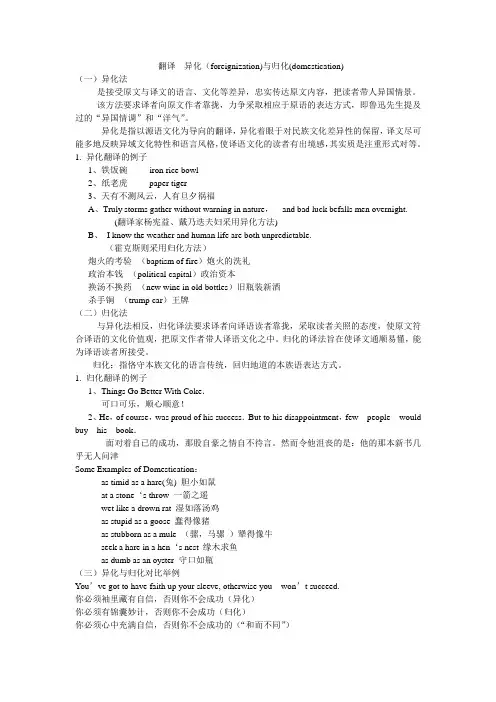
翻译---异化(foreignization)与归化(domestication)(一)异化法是接受原文与译文的语言、文化等差异,忠实传达原文内容,把读者带人异国情景。
该方法要求译者向原文作者靠拢,力争采取相应于原语的表达方式,即鲁迅先生提及过的“异国情调”和“洋气”。
异化是指以源语文化为导向的翻译,异化着眼于对民族文化差异性的保留,译文尽可能多地反映异域文化特性和语言风格,使译语文化的读者有出境感,其实质是注重形式对等。
1. 异化翻译的例子1、铁饭碗iron rice bowl2、纸老虎paper tiger3、天有不测风云,人有旦夕祸福A、Truly storms gather without warning in nature,and bad luck befalls men overnight.(翻译家杨宪益、戴乃迭夫妇采用异化方法)B、I know the weather and human life are both unpredictable.(霍克斯则采用归化方法)炮火的考验--(baptism of fire)炮火的洗礼政治本钱--(political capital)政治资本换汤不换药--(new wine in old bottles)旧瓶装新酒杀手锏--(trump car)王牌(二)归化法与异化法相反,归化译法要求译者向译语读者靠拢,采取读者关照的态度,使原文符合译语的文化价值观,把原文作者带人译语文化之中。
归化的译法旨在使译文通顺易懂,能为译语读者所接受。
归化:指恪守本族文化的语言传统,回归地道的本族语表达方式。
1. 归化翻译的例子1、Things Go Better With Coke.可口可乐,顺心顺意!2、He,of course,was proud of his success.But to his disappointment,few people would buy his book.面对着自已的成功,那股自豪之情自不待言。
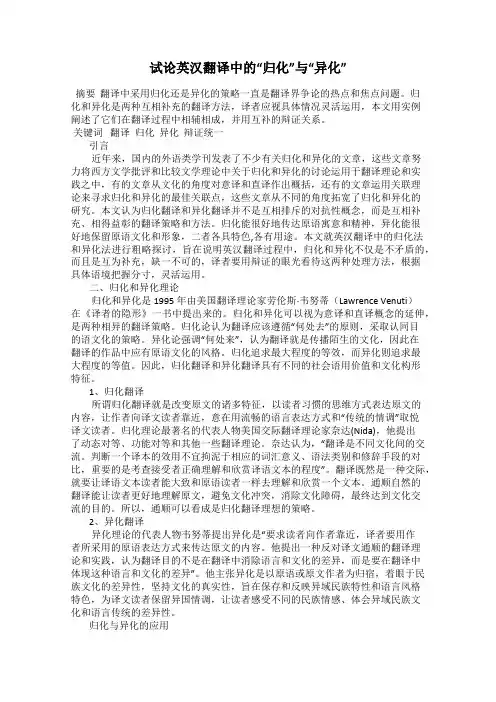
试论英汉翻译中的“归化”与“异化”摘要翻译中采用归化还是异化的策略一直是翻译界争论的热点和焦点问题。
归化和异化是两种互相补充的翻译方法,译者应视具体情况灵活运用,本文用实例阐述了它们在翻译过程中相辅相成,并用互补的辩证关系。
关键词翻译归化异化辩证统一引言近年来,国内的外语类学刊发表了不少有关归化和异化的文章,这些文章努力将西方文学批评和比较文学理论中关于归化和异化的讨论运用于翻译理论和实践之中,有的文章从文化的角度对意译和直译作出概括,还有的文章运用关联理论来寻求归化和异化的最佳关联点,这些文章从不同的角度拓宽了归化和异化的研究。
本文认为归化翻译和异化翻译并不是互相排斥的对抗性概念,而是互相补充、相得益彰的翻译策略和方法。
归化能很好地传达原语寓意和精神,异化能很好地保留原语文化和形象,二者各具特色,各有用途。
本文就英汉翻译中的归化法和异化法进行粗略探讨,旨在说明英汉翻译过程中,归化和异化不仅是不矛盾的,而且是互为补充,缺一不可的,译者要用辩证的眼光看待这两种处理方法,根据具体语境把握分寸,灵活运用。
二、归化和异化理论归化和异化是1995年由美国翻译理论家劳伦斯·韦努蒂(Lawrence Venuti)在《译者的隐形》一书中提出来的。
归化和异化可以视为意译和直译概念的延伸,是两种相异的翻译策略。
归化论认为翻译应该遵循“何处去”的原则,采取认同目的语文化的策略。
异化论强调“何处来”,认为翻译就是传播陌生的文化,因此在翻译的作品中应有原语文化的风格。
归化追求最大程度的等效,而异化则追求最大程度的等值。
因此,归化翻译和异化翻译具有不同的社会语用价值和文化构形特征。
1、归化翻译所谓归化翻译就是改变原文的诸多特征,以读者习惯的思维方式表达原文的内容,让作者向译文读者靠近,意在用流畅的语言表达方式和“传统的情调”取悦译文读者。
归化理论最著名的代表人物美国交际翻译理论家奈达(Nida),他提出了动态对等、功能对等和其他一些翻译理论。
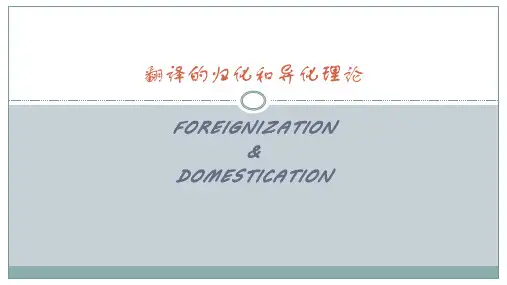

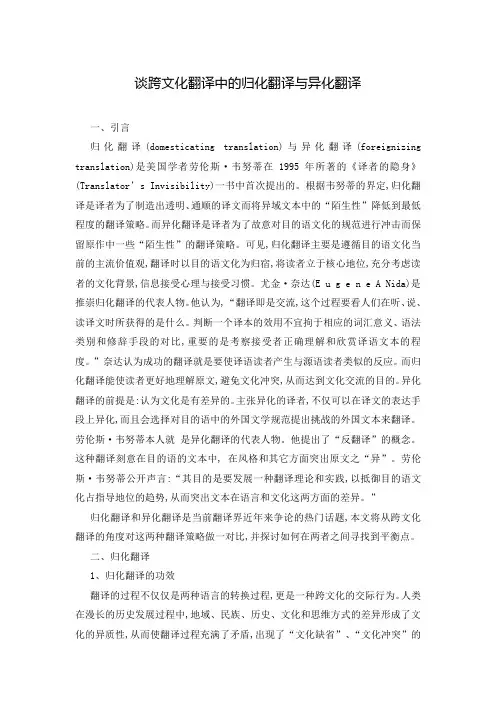
谈跨文化翻译中的归化翻译与异化翻译一、引言归化翻译(domesticating translation)与异化翻译(foreignizing translation)是美国学者劳伦斯·韦努蒂在1995年所著的《译者的隐身》(Translator’s Invisibility)一书中首次提出的。
根据韦努蒂的界定,归化翻译是译者为了制造出透明、通顺的译文而将异域文本中的“陌生性”降低到最低程度的翻译策略。
而异化翻译是译者为了故意对目的语文化的规范进行冲击而保留原作中一些“陌生性”的翻译策略。
可见,归化翻译主要是遵循目的语文化当前的主流价值观,翻译时以目的语文化为归宿,将读者立于核心地位,充分考虑读者的文化背景,信息接受心理与接受习惯。
尤金·奈达(E u g e n e A Nida)是推崇归化翻译的代表人物。
他认为,“翻译即是交流,这个过程要看人们在听、说、读译文时所获得的是什么。
判断一个译本的效用不宜拘于相应的词汇意义、语法类别和修辞手段的对比,重要的是考察接受者正确理解和欣赏译语文本的程度。
”奈达认为成功的翻译就是要使译语读者产生与源语读者类似的反应。
而归化翻译能使读者更好地理解原文,避免文化冲突,从而达到文化交流的目的。
异化翻译的前提是:认为文化是有差异的。
主张异化的译者,不仅可以在译文的表达手段上异化,而且会选择对目的语中的外国文学规范提出挑战的外国文本来翻译。
劳伦斯·韦努蒂本人就是异化翻译的代表人物。
他提出了“反翻译”的概念。
这种翻译刻意在目的语的文本中, 在风格和其它方面突出原文之“异”。
劳伦斯·韦努蒂公开声言:“其目的是要发展一种翻译理论和实践,以抵御目的语文化占指导地位的趋势,从而突出文本在语言和文化这两方面的差异。
”归化翻译和异化翻译是当前翻译界近年来争论的热门话题,本文将从跨文化翻译的角度对这两种翻译策略做一对比,并探讨如何在两者之间寻找到平衡点。
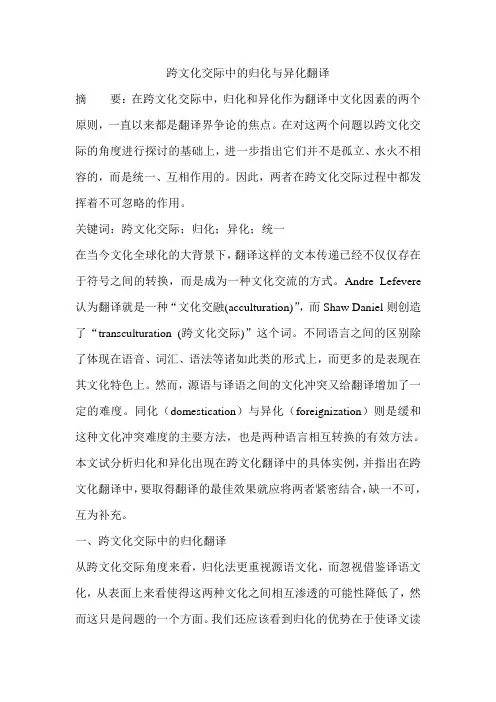
跨文化交际中的归化与异化翻译摘要:在跨文化交际中,归化和异化作为翻译中文化因素的两个原则,一直以来都是翻译界争论的焦点。
在对这两个问题以跨文化交际的角度进行探讨的基础上,进一步指出它们并不是孤立、水火不相容的,而是统一、互相作用的。
因此,两者在跨文化交际过程中都发挥着不可忽略的作用。
关键词:跨文化交际;归化;异化;统一在当今文化全球化的大背景下,翻译这样的文本传递已经不仅仅存在于符号之间的转换,而是成为一种文化交流的方式。
Andre Lefevere 认为翻译就是一种“文化交融(acculturation)”,而Shaw Daniel则创造了“transculturation (跨文化交际)”这个词。
不同语言之间的区别除了体现在语音、词汇、语法等诸如此类的形式上,而更多的是表现在其文化特色上。
然而,源语与译语之间的文化冲突又给翻译增加了一定的难度。
同化(domestication)与异化(foreignization)则是缓和这种文化冲突难度的主要方法,也是两种语言相互转换的有效方法。
本文试分析归化和异化出现在跨文化翻译中的具体实例,并指出在跨文化翻译中,要取得翻译的最佳效果就应将两者紧密结合,缺一不可,互为补充。
一、跨文化交际中的归化翻译从跨文化交际角度来看,归化法更重视源语文化,而忽视借鉴译语文化,从表面上来看使得这两种文化之间相互渗透的可能性降低了,然而这只是问题的一个方面。
我们还应该看到归化的优势在于使译文读来比较地道和生动,将译语文化作为归宿点,同时又试图将源语文本完全纳入译语文化体系,这带来的直接受益就是避免了文化冲突,实现了跨文化交流。
汉语里有许多成语或者习语在英语语言里找不与之完全对应的翻译方法其实是很难的。
最常见的一种情况就是表达不一、内涵一致。
我们在翻译这些成语俗语的时候,应注意比较二者之间的内涵意义,用归化法来翻译则易于被读者理解,读起来比较地道、生动,同时可产生异曲同工之妙境。
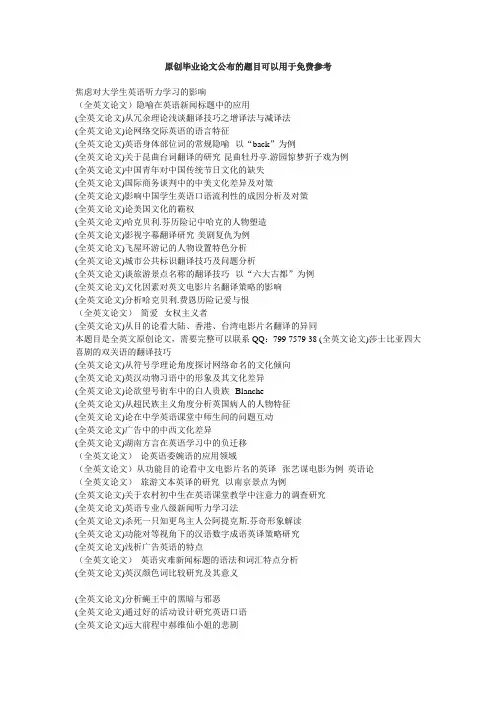
原创毕业论文公布的题目可以用于免费参考焦虑对大学生英语听力学习的影响(全英文论文)隐喻在英语新闻标题中的应用(全英文论文)从冗余理论浅谈翻译技巧之增译法与减译法(全英文论文)论网络交际英语的语言特征(全英文论文)英语身体部位词的常规隐喻--以“back”为例(全英文论文)关于昆曲台词翻译的研究-昆曲牡丹亭.游园惊梦折子戏为例(全英文论文)中国青年对中国传统节日文化的缺失(全英文论文)国际商务谈判中的中美文化差异及对策(全英文论文)影响中国学生英语口语流利性的成因分析及对策(全英文论文)论美国文化的霸权(全英文论文)哈克贝利.芬历险记中哈克的人物塑造(全英文论文)影视字幕翻译研究-美剧复仇为例(全英文论文)飞屋环游记的人物设置特色分析(全英文论文)城市公共标识翻译技巧及问题分析(全英文论文)谈旅游景点名称的翻译技巧--以“六大古都”为例(全英文论文)文化因素对英文电影片名翻译策略的影响(全英文论文)分析哈克贝利.费恩历险记爱与恨(全英文论文)简爱--女权主义者(全英文论文)从目的论看大陆、香港、台湾电影片名翻译的异同本题目是全英文原创论文,需要完整可以联系QQ:799 7579 38 (全英文论文)莎士比亚四大喜剧的双关语的翻译技巧(全英文论文)从符号学理论角度探讨网络命名的文化倾向(全英文论文)英汉动物习语中的形象及其文化差异(全英文论文)论欲望号街车中的白人贵族--Blanche(全英文论文)从超民族主义角度分析英国病人的人物特征(全英文论文)论在中学英语课堂中师生间的问题互动(全英文论文)广告中的中西文化差异(全英文论文)湖南方言在英语学习中的负迁移(全英文论文)论英语委婉语的应用领域(全英文论文)从功能目的论看中文电影片名的英译--张艺谋电影为例_英语论(全英文论文)旅游文本英译的研究--以南京景点为例(全英文论文)关于农村初中生在英语课堂教学中注意力的调查研究(全英文论文)英语专业八级新闻听力学习法(全英文论文)杀死一只知更鸟主人公阿提克斯.芬奇形象解读(全英文论文)功能对等视角下的汉语数字成语英译策略研究(全英文论文)浅析广告英语的特点(全英文论文)英语灾难新闻标题的语法和词汇特点分析(全英文论文)英汉颜色词比较研究及其意义(全英文论文)分析蝇王中的黑暗与邪恶(全英文论文)通过好的活动设计研究英语口语(全英文论文)远大前程中郝维仙小姐的悲剧(全英文论文)纯真年代中梅•韦兰和爱伦•奥兰斯卡的形象分析(全英文论文)论英语广告中的隐喻及其翻译(全英文论文)论小学生英语写作能力培养的策略(全英文论文)农村中学初中英语分层次教学研究—以XX中学为例(全英文论文)浅析夜色温柔中迪克“迷惘的一代”的人物形象(全英文论文)从禁忌语角度看中西方文化之间的差异(全英文论文)芭芭拉.史密斯的黑人女性主义批评视角看宠儿的弑婴母题(全英文论文)商务合同中汉译准确性的研究(全英文论文)浅析中美婚礼习俗差异(全英文论文)从美国俚语探讨反文化现象(全英文论文)从认知角度浅析王尔德童话中隐喻的运用(全英文论文)中西文化面子观差异对比分析(全英文论文)山寨文化的反思发展与创新(全英文论文)全球化背景下的中国英语研究(全英文论文)目的论视角下英文电影字幕的汉译--环太平洋为例(全英文论文)语篇范围内的构式研究-美国总统就职演说作为案例(全英文论文)分析英语动词时和体(全英文论文)从汉英宠物词汇的内涵看中西方文化差异(全英文论文)兴趣在初中生英语学习中的作用调查报告--XX中学的学生为例(全英文论文)中国“龙”意象的变化与翻译策略的调整(全英文论文)政治演讲的文体分析-以英国首相丘吉尔的两篇演讲辞为例(全英文论文)弗吉尼亚•伍尔夫到灯塔去的象征意义解读(全英文论文)论喜福会中母亲对女儿的影响(全英文论文)论欧亨利的写作技巧(全英文论文)情景语境下的初中英语词汇教学(全英文论文)老人与海中的象征手法(全英文论文)英语专业学生自主学习能力培养(全英文论文)民族文化因素在中国和美国动画产业中的差异研究(全英文论文)浅析60年代美国嬉皮士文化---“逍遥骑士”(全英文论文)高三学生不同英语学习风格对学习成绩的影响(全英文论文)概念隐喻视角下的图形背景论—以时间事件为例(全英文论文)我校英语专业学生二语写作中名词短语的使用情况分析(全英文论文)高校教师如何激发学生的英语学习动机(全英文论文)单词出现频率与英语词汇习得关系的实证研究(全英文论文)浅析圣诞文化对中国大陆社会生活的影响(全英文论文)中西饮食文化差异分析(全英文论文)中文旅游景点解说词的特点及翻译策略(全英文论文)欧.亨利短篇小说的艺术技巧(全英文论文)非语言交际在英语教学中的重要性(全英文论文)英汉天气词汇的隐喻用法(全英文论文)西风颂和秋颂的对比分析(全英文论文)功能翻译理论指导下的对外宣传翻译(全英文论文)交际法在初中英语口语教学中的应用(全英文论文)从生态批评角度解析愤怒的葡萄(全英文论文)语用预设和大学英语听力(全英文论文)试从动物习语分析比较中英文化差异(全英文论文)汤姆叔叔的小屋中的圣经人物原型分析(全英文论文)论语外知识在口译中的重要性(全英文论文)美国家庭和越南家庭的差异(全英文论文)交际文化在商务活动中的应用(全英文论文)英语广告翻译原则与技巧成语汉译英中数字的对等(全英文论文)罗密欧与朱丽叶和梁山伯与祝英台结局对比(全英文论文)英汉颜色词国俗语义对比研究(全英文论文)浅谈功能对等理论在中英商标翻译中的应用(全英文论文)傲慢与偏见中傲慢和偏见的成因。
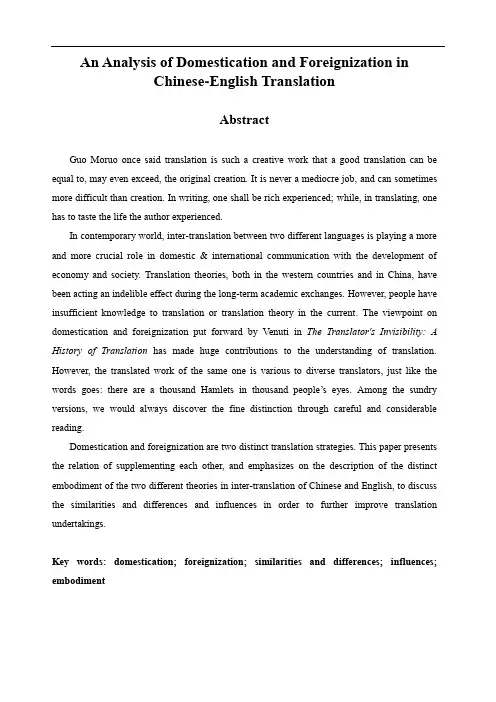
An Analysis of Domestication and Foreignization inChinese-English TranslationAbstractGuo Moruo once said translation is such a creative work that a good translation can be equal to, may even exceed, the original creation. It is never a mediocre job, and can sometimes more difficult than creation. In writing, one shall be rich experienced; while, in translating, one has to taste the life the author experienced.In contemporary world, inter-translation between two different languages is playing a more and more crucial role in domestic & international communication with the development of economy and society. Translation theories, both in the western countries and in China, have been acting an indelible effect during the long-term academic exchanges. However, people have insufficient knowledge to translation or translation theory in the current. The viewpoint on domestication and foreignization put forward by Venuti in The Translator's Invisibility: A History of Translation has made huge contributions to the understanding of translation. However, the translated work of the same one is various to diverse translators, just like the words goes: there are a thousand Hamlets in thousand people’s eyes. Among the sundry versions, we would always discover the fine distinction through careful and considerable reading.Domestication and foreignization are two distinct translation strategies. This paper presents the relation of supplementing each other, and emphasizes on the description of the distinct embodiment of the two different theories in inter-translation of Chinese and English, to discuss the similarities and differences and influences in order to further improve translation undertakings.Key words: domestication; foreignization; similarities and differences; influences; embodiment摘要郭沫若先生曾说:翻译是一种创造性工作,好的翻译等于创作,甚至还可能超过创作。

- 214 -校园英语 /论商务英语翻译中归化与异化的应用云南师范大学外国语学院/卢维诗【摘要】本文通过对商务英语翻译的概念分析以及归化和异化理论的阐述,以实际语例详细剖析归化和异化在商务英语翻译中的应用。
最终得出在商务英语翻译中当采取归化为主要的翻译策略,异化为次要的翻译的策略。
【关键词】商务英语翻译 归化 异化【Abstract 】This paper carefully analysize the application of domestication and foreignization in the business english translation with clarifying the concepts of the business English translation ,domestication and foreignization.At last we hold that the domestication is considered as the main translation strategy and the foreignization is the supplement one.【Key words 】business English translation; domestication; foreignization一、商务英语翻译概念的界定对于普通英语的翻译或者文学翻译,译者主要需要精通翻译所涉及的源语和目的语,源语文化和目的语文化。
而商务英语翻译时,译者除了要精通以上信息,还必须充分了解商务英语所涉及的商务专业知识和商务文化。
鲍文推论出了商务英语翻译的概念:商务英语翻译是指译者将一种语言(源语)所表达的商务信息准确有效地转换成另外一种语言(目的语)的活动。
归化和异化在商务英语翻译中的应用归根结底是如何处理跨文化的问题。
文化因素体现在语言的各个层面,如词汇,语句,语篇等。
翻译中的异化与归化1813年,德国古典语言学家、翻译理论家施莱尔马赫在《论翻译的方法》中提出:翻译的途径“只有两种:一种是尽可能让作者安居不动,而引导读者去接近作者;另一种是尽可能让读者安居不动,而引导作者去接近读者。
”在这里,施氏只是描述了他所说的两种方法,并未授之以什么名称。
1995年,美国翻译理论家劳伦斯·韦努蒂在其The Translator's Invisibility一书中,将第一种方法称作“异化法”(foreignizing method),将第二种方法称作“归化法”(domesticating method)。
(Venuti,1995:20)概括而言,异化法要求译者向作者靠拢,采取相应于作者所使用的源语表达方式,来传达原文的内容;而归化法则要求译者向目的语读者靠拢,采取目的语读者所习惯的目的语表达方式,来传达原文的内容。
从这个界定来看,异化大致相当于直译,归化大致相当于意译,但异化、归化似乎更加原则化。
异化(foreignizing)和归化(domesticating)作为两种主要的翻译方法历来是翻译界争论的焦点之一。
异化是要保存原语的异国情调,就是所谓“洋气”;归化则是用译语文化中惯用的表达方式来转换原语。
一、一方面,世界范围内的人类的经历相似性造就了文化的可译性。
就这点来讲,奈达(Nida)曾讲过“所有的人类都要吃饭、工作、睡觉和生育,他们制造如家俱、工具及车辆等器物。
他们还组成家庭、家族、内部集团和外部集团、国家以及国家间的组织。
他们对于宇宙、价值、宗教和超自然力有着意识上的相似性。
事实上,世界上不同人群的相同之处远远超过相异之处。
”正是由于不同民族文化的相似性,才使得不同文化的人民可以相互理解,使翻译成为可能。
奈达因此指出:“语言学家和人类学家发现使人类联系在一起的因素远远多于使之相疏离的因素,这是产生交流的基础。
”许多一种文化中特有的表达,都可以在另一文化中找到几乎同样的表达,成为文化可译性的最好佐证。
异化翻译与归化翻译异化翻译法(或异化法) (foreignizing translation or minoritizing translation) 和归化翻译法(或归化法) ( domesticating translation or domestication) 是美国翻译理论家Lawrence Venuti (1995)创造出来用来描述翻译策略的两个术语。
异化翻译法是故意使译文冲破目的语的常规,保留原文中的异国情调。
Venuti 把异化翻译法归因于19 世纪德国哲学家Schleiermacher 的翻译论说“译者尽量不惊动原作者,让读者向他靠近”( Schleiermacher , 1838P1963 : 47 , 1838P1977 : 74 ;V enuti ,1995 :19) 。
Schleiermacher 本人是赞同采用异化法的。
Venuti (1995 :20) 指出,在盲目自大地使用单语并把归化翻译法作为标准的文化社会(例如英美社会) 中应提倡异化翻译法。
在这种情况下采用异化法是一种对当时的社会状况进行文化干预的策略,因为这是对主导文化心理的一种挑战。
主导文化心理总是尽力压制译文中的异国情调(或“异物”) 。
Venuti 把异化翻译描述成一种“背离民族的压力”(1995 :20) ,其作用是“把外国文本中的语言文化差异注入目的语之中,把读者送到国外去”(1995 :20) 。
具体来说,异化翻译法包括以下特点: (1)不完全遵循目的语语言与语篇规范; (2) 在适当的时候选择不通顺、艰涩难懂的文体; (3) 有意保留源语中的实观材料或采用目的语中的古词语; (4) 目的是为目的语读者提供一次“前所未有的阅读经验”(1995 : 20) 。
不过,Venuti 也承认,译文是由“本土的文化材料”组成的,异化翻译(像归化翻译那样) 只能是翻译过程中的一种策略,所不同的是,采用异化法的译者一般都态度鲜明,而不是隐隐匿匿(1995 :34) 。
英语广告翻译中的归化与异化Domestication versus Foreignizationin English Advertisement Translation英语广告翻译中的归化与异化The present paper focuses on the application of the two translating strategies--domestication and foreignization to English advertisement translation. Why does a translator choose this translation strategy instead of that one when he translates an advertisement? In the consumers’ eyes, what kind of advertisements do they expect and would get their attention?1. Definition of Domestication and ForeignizationIn translation, there are two basic translation strategies, which are termed “domesticating” and “foreignizing” by Lawrence Venuti (Venuti 2004).The roots of the terms can be traced back to the German Philosopher Schleiermacher’s argument in his famous lecture “On the Different Ways of Translating” given in 1813. In that lecture, he argued that there are only two different methods of translation, “either the translator l eaves the author in peace as much as possible, and moves the reader towards him; or he leaves the reader in peace as much as possible, and moves the author towards him.” (Venuti 2004: 19-20) 2.Functions of Domestication and ForeignizationAs is mentioned, translation is a matter of choice. The strategies of domestication and foreignization have their respective advantages and limitations which decide their different functions in the translating work.Domesticating translation is easier for the readers to understand and accept, because expressions and styles familiarto the TL readers are adopted. However, the naturalness and smoothness of the TL are often achieved at the expense of the cultural and stylistic message of the SL; while the foreignizing strategy seeks to evoke a sense of the foreign freshness. The function of domestication is to shorten the distance of the author and the readers, while the function of foreignization is to bring the readers to the author’s world.3. Application of Domestication and Foreignization to English Advertisement TranslationAdvertisement is of a very practical type of writing with high commercial value. Its ultimate purpose is to promote sales. If the translator rigidly adheres to the original form and content in translation, it may lead to the failure of promoting sales in target markets.Translating advertisements is something like presenting one the tip of an iceberg. What one sees are the words, but there is a lot behind the words that must be。
从纽马克的翻译理论看商务英语翻译的归化与异化Views on Domestication and Foreignization Translation of Business English from Point of Newmark’s Translation Theory//Yang QinAbstract One of the most important factors determining the way of a translation is the purpose of the translation. It is Newmark’s most important contribution that he has made detailed introduction to communicative translation and semantic translation. The paper adapts Peter Newmark’s translation theory to help analyze the domestication and foreignization in translating business English.Key words style;communicative translation;semantic translation;domestication vs. foreignizationAuthor’s addr ess Department of Foreign Languages, Guangzhou University Songtian College, Guangzhou *****1 从纽马克的翻译理论到归化异化纽马克借用前人的模式按语言不同功能把文章分为以表达功能为主的文章、以信息功能为主的文章和以呼唤功能为主的文章。
因此,译者可以针对不同类型的文体采用不同的翻译策略。
论翻译的两种策略:归化与异化(李圣云,北京第二外国语学院法语系,硕士,研究方向:翻译、教学法)摘要:归化和异化作为两种翻译策略,孰优孰劣,不能一概而论;它们都有各自的优缺点。
归化和异化的选择受众多因素的影响,如政治、风俗习惯、审美情趣、翻译目的等。
归化翻译和异化翻译只要都符合忠实性的三要素,那么它们都是忠实的翻译。
Brief:It’s not reasonable to judge the Foreignizing Method and the Domesticating Method by generalization; each method has its own advantages and disadvantages. Many factors play roles in choosing between those 2 methods, such as politics, custom, aesthetics and translation purpose etc. Foreignization translation and domestication translation, each of them could be regarded as loyal translation if it goes under the 3 elements of Loyalty Principle.关键词:翻译,归化,异化自奈达把文化概念引入翻译中以来,翻译理论家和实践者就如何处理语言外因素提出各种疑问。
和原来翻译界争执不休的“直译”和“意译”不同,他们更关注文化因素在翻译中的得失,因为语言是文化的载体,两种语言的不同不只是语言文字、遣词造句等语言形式的不同,她们蕴含的两种文化的不同之处也会在文章的字里行间传递出来。
在翻译中,对于如何处理原文特有的文化信息,翻译家们持两种意见:有些翻译家建议删除原文特有的、译文读者不熟悉的那些文化差异,或者将这些差异转化为译文读者熟悉、和原文对等的译入语中的文化现象;另一些翻译家提倡保留原文语言和非语言的特性,以便译文读者能欣赏原文的异域美,拓展知识。
论翻译的两种策略:归化与异化(李圣云,北京第二外国语学院法语系,硕士,研究方向:翻译、教学法)摘要:归化和异化作为两种翻译策略,孰优孰劣,不能一概而论;它们都有各自的优缺点。
归化和异化的选择受众多因素的影响,如政治、风俗习惯、审美情趣、翻译目的等。
归化翻译和异化翻译只要都符合忠实性的三要素,那么它们都是忠实的翻译。
Brief:It’s not reasonable to judge the Foreignizing Method and the Domesticating Method by generalization; each method has its own advantages and disadvantages. Many factors play roles in choosing between those 2 methods, such as politics, custom, aesthetics and translation purpose etc. Foreignization translation and domestication translation, each of them could be regarded as loyal translation if it goes under the 3 elements of Loyalty Principle.关键词:翻译,归化,异化自奈达把文化概念引入翻译中以来,翻译理论家和实践者就如何处理语言外因素提出各种疑问。
和原来翻译界争执不休的“直译”和“意译”不同,他们更关注文化因素在翻译中的得失,因为语言是文化的载体,两种语言的不同不只是语言文字、遣词造句等语言形式的不同,她们蕴含的两种文化的不同之处也会在文章的字里行间传递出来。
在翻译中,对于如何处理原文特有的文化信息,翻译家们持两种意见:有些翻译家建议删除原文特有的、译文读者不熟悉的那些文化差异,或者将这些差异转化为译文读者熟悉、和原文对等的译入语中的文化现象;另一些翻译家提倡保留原文语言和非语言的特性,以便译文读者能欣赏原文的异域美,拓展知识。
2010届本科生毕业设计(论文) 毕业论文 Domestication or Foreignism-oriented Skills in Translation
学 院: 外国语学院 专 业: 姓 名: 指导老师: 英语专业 xx 学 号: 职 称: xx 译 审
中国·珠海 二○一 ○ 年 五 月 xx海学院毕业论文 诚信承诺书
本人郑重承诺:我所呈交的毕业论文Domestication or Foreignism-oriented Skills in Translation 是在指导教师的指导下,独立开展研究取得的成果,文中引用他人的观点和材料,均在文后按顺序列出其参考文献,论文使用的数据真实可靠。
承诺人签名: 日期: 年 月 日 I
Domestication or Foreignism-oriented Skills in Translation ABSTRACT Translation, a bridge between different languages and cultures, plays an indispensable role in cross-culture communication. However, as a translator, we have to choose which strategy to deal with the cultural differences between the source language and the target language in the process of translation where there exists two major translation strategies--- domestication and foreignization. In this thesis, I will discuss these strategies and their application from translation, linguistics, and cross-cultural communication perspectives. In the thesis, I will first talk about the current research of the domestication and foreignization in the translation circle as well as point out the necessity for further research. Then, I will illustrate the relationship between linguistics and translation as well as between culture and translating and next systematically discuss these two translation strategies including their definitions, the controversy in history and their current studies. Besides, I will continue to deal with such neglected factors as may influence the translator’s choice of translation strategies: the type of the source text (ST), the translation purposes, the level of the intended readers, the social and historical background, the translator’s attitude and so on. Finally, from the linguistic and cultural perspectives, the thesis makes a comparative study of the application of domestication and foreignization by analyzing typical examples from the two English versions of Hong Lou Meng translated by Yang Xianyi and David Hawkes respectively. The thesis will conclude that these two translation strategies have their respective features and applicable value. I sincerely hope that this research into translation strategies will enlighten translators and make a little contribution to the prosperity of II
translation studies and translation practice in China. Key words: translation strategy; domestication; foreignization; application III 归化与异化翻译
摘 要
翻译作为沟通不同语言与文化的桥梁,在跨文化交际中起着不可或缺的作用。译者在翻译的过程中总会面临翻译策略的选择。翻译策略是指译者在处理源语与译语语言文化差异时所用的方法。在翻译中有两种基本策略:归化和异化。本文主要从翻译学、语言学和跨文化交际的角度来讨论这两种翻译策略以及他们的应用。 首先,文章概述了国内外翻译界对归化与异化研究的现状并指出继续深入研究的必要性;接着论述了语言、文化与翻译之间的相互关系;然后系统地讨论归化和异化这两种翻译策略,包括他们的定义,历史上的有关争论和当前的研究现状,并阐述了作者的观点。接下来本文讨论了影响译者选择翻译策略的因素,例如:文本类型、目标语读者的水平、翻译的社会历史背景、译者的翻译的目的及其文化态度等等。作者试图通过对这些因素进行详细分析,并结合具体例子,分别从语言和文化层面对中国古典名著《红楼梦》的两个英译本中归化与异化的应用进行比较研究(杨宪益译本和霍克斯译本),来论证异化与归化看似矛盾,实则相互补充的辩证关系;异化和归化因其各具特点,在不同情况下都有其存在的价值,过于强调其中的一种是片面的,不科学的;译者应该根据文本类型、翻译目的和读者水平等因素来选择合适的翻译策略,绝对归化和绝对异化都是行不通的。 希望本文对翻译策略的研究能够给译者以启发,并达到进一步加强和丰富翻译理论、指导翻译实践的目的。 关键词:翻译策略;归化;异化;应用 IV
CONTENTS Abstract…………………………………………..…………..……..I 摘要……………………………………………………………… Ⅲ Chapter1 Introduction ........................................................................... 1
1.1 The Cultural Turn in the Study of Translation ................................ 1 1.2 Studies of Domestication and Foreignization ................................. 3 1.3 The Purpose, Significance and the Framework of the Thesis ........ 4 Chapter 2 Towards Domestication and Foreignization .................. 5
2.1 Definitions of Domestication and Foreignization .......................... 5 2.2 The Disputes over Domestication and Foreignization in History .. 7 2.3Why Have the Disputes Always Been Going on? ........................... 8 2.4 Advantages and Disadvantages of Domestication and Foreignization ....................................................................................... 9 Chapter 3 Factors that Influence Translator’s Selection of Translation Strategies .......................................................................... 11
3.1 Types of Text ................................................................................. 11 3.2 Social and Cultural Background ................................................... 15 3.3 Target Language Readers .............................................................. 15 3.4 Translator’s Attitude ..................................................................... 17 Chapter 4 The Application of the Two Strategies to the Two English Versions of Hong Lou Meng ................................................. 19